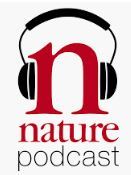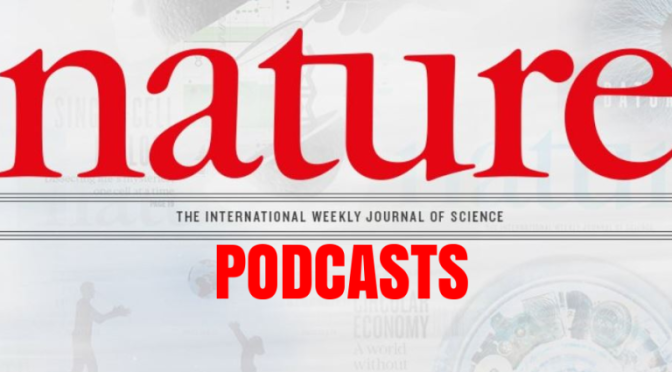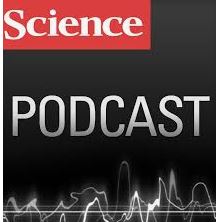Tag Archives: Science Podcasts
Top New Science Podcasts: 100-Million-Year-Old Bird In Amber And Viking Dental Hygiene (Nature)
 Hear the latest science news, brought to you by Shamini Bundell and Nick Howe. This week, a newly discovered bird species from the time of the dinosaurs, and microbes hundreds of metres below the ocean floor.
Hear the latest science news, brought to you by Shamini Bundell and Nick Howe. This week, a newly discovered bird species from the time of the dinosaurs, and microbes hundreds of metres below the ocean floor.
In this episode:
00:44 A tiny, toothy, ancient bird
Researchers have found a perfectly preserved bird fossil trapped in amber, with some rather unusual features. Research Article: Xing et al.; News and Views: Tiny bird fossil might be the world’s smallest dinosaur
08:09 Research Highlights
Dental hygiene in the time of the Vikings, and wildebeest bones feed an African ecosystem. Research Article: Bertilsson et al; Research Article: Subalusky et al.
10:21 Deep sea life
Scientists have uncovered traces of life 750m below the ocean’s surface. Research article: Li et al.
17:31 News Chat
Updates on the Coronavirus outbreak, and peer review in predatory journals. News: Coronavirus: latest news on spreading infection; News: Labs rush to study coronavirus in transgenic animals — some are in short supply; News: Hundreds of scientists have peer-reviewed for predatory journals
New Science Podcasts: Dogs’ Cold Noses Sense Heat, Coronavirus And The Search For Alien Life
And finally, from a recording made at this year’s AAAS annual meeting, host Meagan Cantwell talks with Jill Tarter, chair emeritus at the SETI Institute, about the newest technologies being used to search for alien life, what a positive signal would look like, and how to inform the public if extraterrestrial life ever were detected.
New Science Podcasts: Faster Image ID, Crafting Crystals And Coronavirus / Covid-19 Update (Nature)
 Listen to the latest from the world of science, with Benjamin Thompson and Nick Howe. This week, improving computers’ image identification, and a new method for growing crystals.
Listen to the latest from the world of science, with Benjamin Thompson and Nick Howe. This week, improving computers’ image identification, and a new method for growing crystals.
In this episode:
00:44 Upgrading computer sight
Researchers have designed a sensor that allows machines to assess images in nanoseconds. Research Article: Mennel et al.; News and Views: In-sensor computing for machine vision
06:51 Research Highlights
Calorie restriction’s effects on rat cells, and the dwindling of sandy seashores. Research Highlight: Old age’s hallmarks are delayed in dieting rats; Research Highlight: Sandy beaches are endangered worldwide as the climate changes
08:53 Crafting crystals
To understand the structure of materials, researchers often have to grow them in crystal form. A new method aims to speed up this process. Research article: Sun et al.
14:48 News Chat
Coronavirus outbreak updates, and climate change’s role in the Australian bush fires. News: Coronavirus: latest news on spreading infection; News: Climate change made Australia’s ‘unprecedented’ bushfires 30% more likely
Top Science Podcasts: A Greater Mayan Empire & Costs Of Illegal Fishing
But was this new ruler of a Maya city really from a separate culture? New techniques being used at the Tikal and Teotihuacan sites have revealed conflicting evidence as to whether Teotihuacan really held sway over a much larger region than previously estimated.
Sarah also talks with Rashid Sumaila, professor and Canada research chair in interdisciplinary ocean and fisheries economics at the University of British Columbia, Vancouver’s Institute for the Oceans and Fisheries. You may have heard of illegal fishing being bad for the environment or bad for maintaining fisheries—but as Sumaila and colleagues report this week in Science Advances, the illegal fishing trade is also incredibly costly—with gross revenues of between $8.9 billion and $17.2 billion each year.
Science Podcasts: Fruit Fly Neural Circuits, Fuzzy Moth Acoustics And Metallic Glass (Nature)
 This week, the brain pathways of egg laying in fruit flies, preventing fractures in metallic glass, moth’s fuzz as superior acoustic camouflage and a coronavirus update.
This week, the brain pathways of egg laying in fruit flies, preventing fractures in metallic glass, moth’s fuzz as superior acoustic camouflage and a coronavirus update.
In this episode:
00:46 Working out the wiring behind fruit fly behaviour
Researchers have identified a neural circuit linking mating and egg laying in female fruit flies. Research Article: Wang et al.
06:01 Research Highlights
Ancient, cave-dwelling cockroaches, and hairy moths dampen sound. Research Highlight: Cockroaches preserved in amber are the world’s oldest cave dwellers; Research Highlight: Stealth flyers: moths’ fuzz is superior acoustic camouflage
07:57 Making better metallic glass
Metallic glasses have many desirable properties, but these materials are prone to fracturing. Now, a new manufacturing process may have overcome this issue. Research article: Pan et al.; News and Views: Metallic glasses rejuvenated to harden under strain
13:47 News Chat
Coronavirus outbreak updates, a survey shows Indian bird numbers are in decline, and the genomes of New York rats. News: Coronavirus: latest news on spreading infection; News: Hundreds of bird species in India are declining; News: Genomes reveal how New York City’s rats thrive in the urban jungle
Top New Science Podcasts: Bacteria Building Bricks, Solar Cells That Turn ‘Waste Heat’ To Electricity
 On this week’s show, Staff Writer Robert F. Service talks with host Sarah Crespi about manipulating microbes to make them produce building materials like bricks—and walls that can take toxins out of the air.
On this week’s show, Staff Writer Robert F. Service talks with host Sarah Crespi about manipulating microbes to make them produce building materials like bricks—and walls that can take toxins out of the air.
Sarah also talks with Paul Davids, principal member of the technical staff in applied photonics & microsystems at Sandia National Laboratories, about an innovation in converting waste heat to electricity that uses similar materials to solar cells but depends on quantum tunneling. And in a bonus segment, producer Meagan Cantwell talks with Online News Editor David Grimm on stage at the AAAS annual meeting in Seattle.
They discuss how wildfires can harm your lungs, crime rates in so-called sanctuary states, and how factors such as your gender and country of origin influence how much trust you put in science.
Top New Science Podcasts: Better Battery Charging, Understanding Mice & Electricity From Thin Air
 This week, machine learning helps batteries charge faster, and using bacterial nanowires to generate electricity from thin air.
This week, machine learning helps batteries charge faster, and using bacterial nanowires to generate electricity from thin air.
In this episode:
00:46 Better battery charging
A machine learning algorithm reveals how to quickly charge batteries without damaging them. Research Article: Attia et al.
07:12 Research Highlights
Deciphering mouse chit-chat, and strengthening soy glue. Research Highlight: The ‘silent’ language of mice is decoded at last; Research Article: Gu et al.
09:21 Harnessing humidity
A new device produces electricity using water in the air. Research Article: Liu et al.
16:30 News Chat
Coronavirus outbreak updates, the global push to conserve biodiversity, and radar reveals secrets in an ancient Egyptian tomb. News: Coronavirus: latest news on spreading infection; News: China takes centre stage in global biodiversity push
Top New Science Podcasts: NIH Grant Diversity, Post-Traumatic Stress Memory Suppression (ScienceMag)
 On this week’s show, senior correspondent Jeffrey Mervis joins host Sarah Crespi to discuss a new National Institutes of Health (NIH) grant program that aims to encourage diversity at the level of university faculty with the long-range goal of increasing the diversity of NIH grant recipients.
On this week’s show, senior correspondent Jeffrey Mervis joins host Sarah Crespi to discuss a new National Institutes of Health (NIH) grant program that aims to encourage diversity at the level of university faculty with the long-range goal of increasing the diversity of NIH grant recipients.
Sarah also talks with Pierre Gagnepain, a cognitive neuroscientist at INSERM, the French biomedical research agency, about the role of memory suppression in post-traumatic stress disorder. Could people that are better at suppressing memories be more resilient to the aftermath of trauma?
Science Podcasts: CRISPR & Immunotherapy, Ice Age Cave Art Dated With Wasp Nests (ScienceMag)
 On this week’s show, Staff Writer Jennifer Couzin-Frankel joins host Sarah Crespi to talk about a Science paper that combines two hot areas of research—CRISPR gene editing and immunotherapy for cancer—and tests it in patients.
On this week’s show, Staff Writer Jennifer Couzin-Frankel joins host Sarah Crespi to talk about a Science paper that combines two hot areas of research—CRISPR gene editing and immunotherapy for cancer—and tests it in patients.
Sarah also talks with Damien Finch, a Ph.D. candidate in the School of Earth Sciences at the University of Melbourne, about the Kimberly region of Australia and dating its ice age cave paintings using charcoal from nearby wasp nests.



 On this week’s show, Online News Editor David Grimm joins host Sarah Crespi to discuss how
On this week’s show, Online News Editor David Grimm joins host Sarah Crespi to discuss how 
